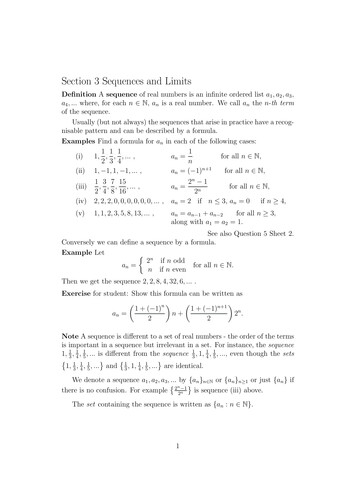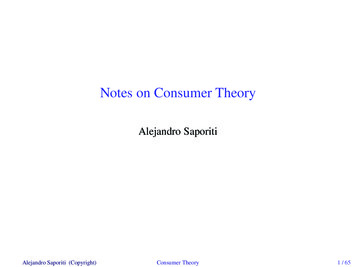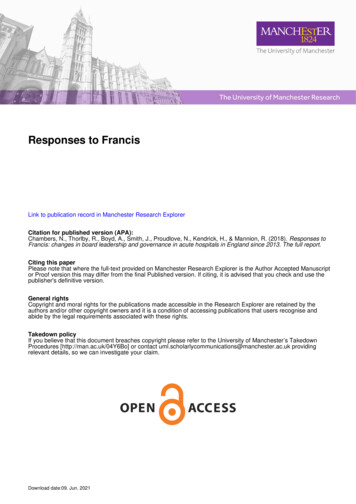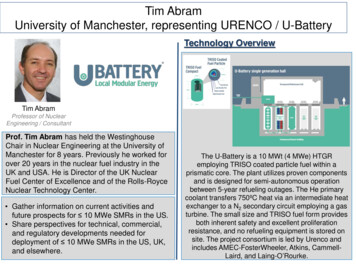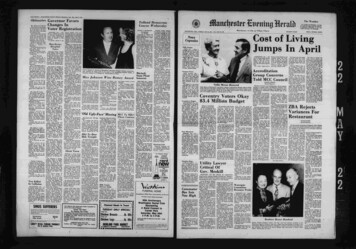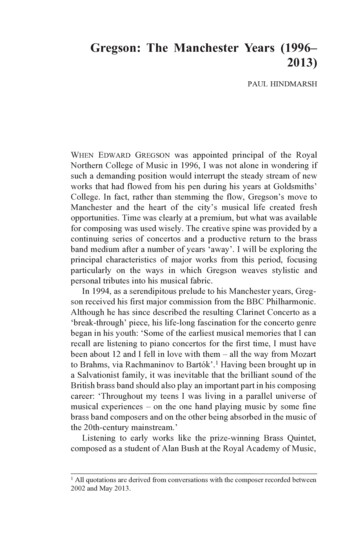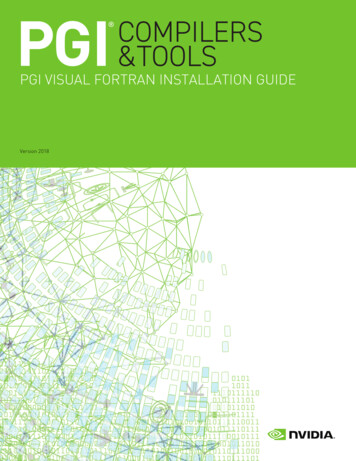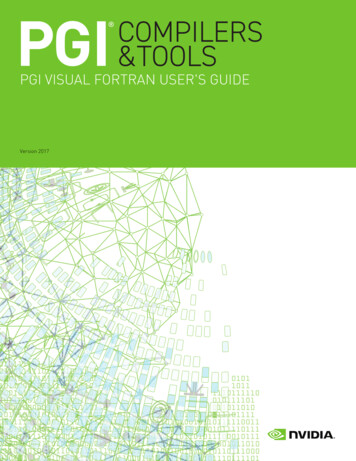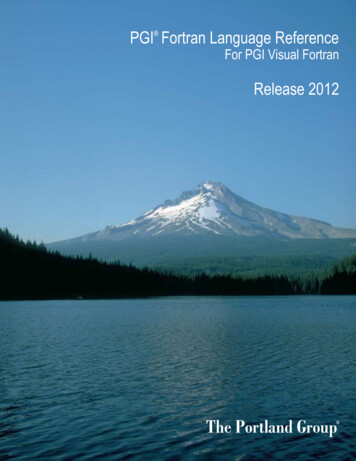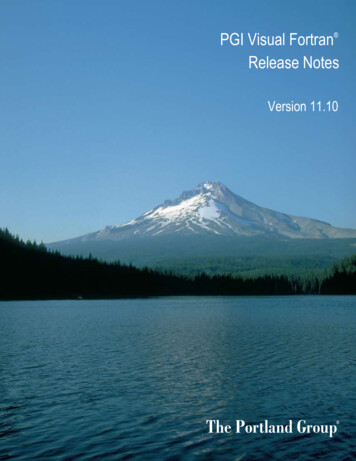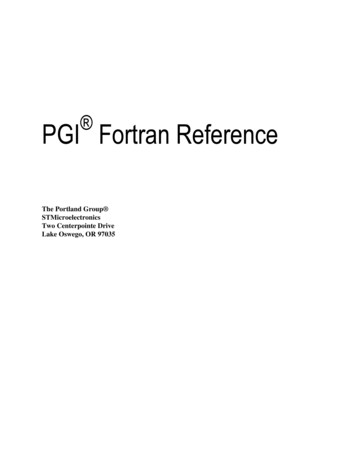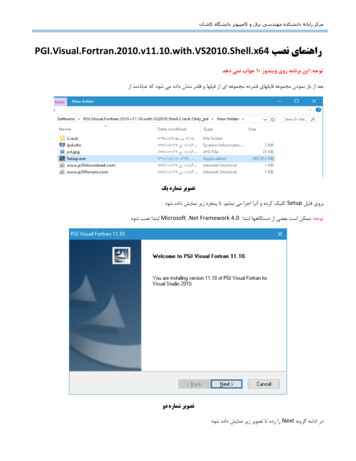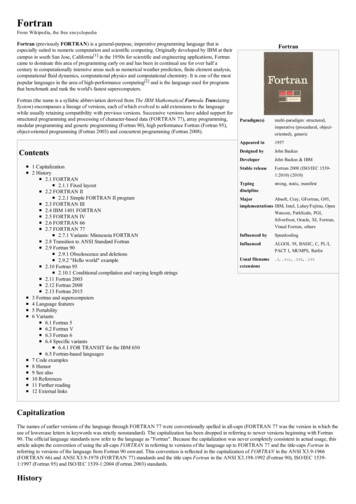
Transcription
FortranFrom Wikipedia, the free encyclopediaFortran (previously FORTRAN) is a general-purpose, imperative programming language that isespecially suited to numeric computation and scientific computing. Originally developed by IBM at theircampus in south San Jose, California[1] in the 1950s for scientific and engineering applications, Fortrancame to dominate this area of programming early on and has been in continual use for over half acentury in computationally intensive areas such as numerical weather prediction, finite element analysis,computational fluid dynamics, computational physics and computational chemistry. It is one of the mostpopular languages in the area of high-performance computing[2] and is the language used for programsthat benchmark and rank the world's fastest supercomputers.Fortran (the name is a syllabic abbreviation derived from The IBM Mathematical Formula TranslatingSystem) encompasses a lineage of versions, each of which evolved to add extensions to the languagewhile usually retaining compatibility with previous versions. Successive versions have added support forstructured programming and processing of character-based data (FORTRAN 77), array programming,modular programming and generic programming (Fortran 90), high performance Fortran (Fortran 95),object-oriented programming (Fortran 2003) and concurrent programming (Fortran 2008).Contents1 Capitalization2 History2.1 FORTRAN2.1.1 Fixed layout2.2 FORTRAN II2.2.1 Simple FORTRAN II program2.3 FORTRAN III2.4 IBM 1401 FORTRAN2.5 FORTRAN IV2.6 FORTRAN 662.7 FORTRAN 772.7.1 Variants: Minnesota FORTRAN2.8 Transition to ANSI Standard Fortran2.9 Fortran 902.9.1 Obsolescence and deletions2.9.2 "Hello world" example2.10 Fortran 952.10.1 Conditional compilation and varying length strings2.11 Fortran 20032.12 Fortran 20082.13 Fortran 20153 Fortran and supercomputers4 Language features5 Portability6 Variants6.1 Fortran 56.2 Fortran V6.3 Fortran 66.4 Specific variants6.4.1 FOR TRANSIT for the IBM 6506.5 Fortran-based languages7 Code examples8 Humor9 See also10 References11 Further reading12 External linksFortranParadigm(s)multi-paradigm: structured,imperative (procedural, objectoriented), genericAppeared in1957Designed byJohn BackusDeveloperJohn Backus & IBMStable releaseFortran 2008 (ISO/IEC 15391:2010) (2010)Typingdisciplinestrong, static, manifestMajorAbsoft, Cray, GFortran, G95,implementations IBM, Intel, Lahey/Fujitsu, OpenWatcom, PathScale, PGI,Silverfrost, Oracle, XL Fortran,Visual Fortran, othersInfluenced bySpeedcodingInfluencedALGOL 58, BASIC, C, PL/I,PACT I, MUMPS, RatforUsual filenameextensions.f , .for , .f90 , .f95CapitalizationThe names of earlier versions of the language through FORTRAN 77 were conventionally spelled in all-caps (FORTRAN 77 was the version in which theuse of lowercase letters in keywords was strictly nonstandard). The capitalization has been dropped in referring to newer versions beginning with Fortran90. The official language standards now refer to the language as "Fortran". Because the capitalization was never completely consistent in actual usage, thisarticle adopts the convention of using the all-caps FORTRAN in referring to versions of the language up to FORTRAN 77 and the title-caps Fortran inreferring to versions of the language from Fortran 90 onward. This convention is reflected in the capitalization of FORTRAN in the ANSI X3.9-1966(FORTRAN 66) and ANSI X3.9-1978 (FORTRAN 77) standards and the title caps Fortran in the ANSI X3.198-1992 (Fortran 90), ISO/IEC 15391:1997 (Fortran 95) and ISO/IEC 1539-1:2004 (Fortran 2003) standards.History
In late 1953, John W. Backus submitted a proposal to his superiors at IBM to develop a more practical alternative to assembly language for programmingtheir IBM 704 mainframe computer. Backus' historic FORTRAN team consisted of programmersRichard Goldberg, Sheldon F. Best, Harlan Herrick, Peter Sheridan, Roy Nutt, Robert Nelson,Irving Ziller, Lois Haibt, and David Sayre.[3] Its concepts included easier entry of equations into acomputer, an idea developed by J. Halcombe Laning and demonstrated in his GEORGE compilerof 1952.[4]A draft specification for The IBM Mathematical Formula Translating System was completed bymid-1954. The first manual for FORTRAN appeared in October 1956, with the first FORTRANcompiler delivered in April 1957. This was the first optimizing compiler, because customers werereluctant to use a high-level programming language unless its compiler could generate code whoseperformance was comparable to that of hand-coded assembly language.[5]An IBM 704 mainframeWhile the community was skeptical that this new method could possibly outperform hand-coding, itreduced the number of programming statements necessary to operate a machine by a factor of 20,and quickly gained acceptance. John Backus said during a 1979 interview with Think, the IBM employee magazine, "Much of my work has come frombeing lazy. I didn't like writing programs, and so, when I was working on the IBM 701, writing programs for computing missile trajectories, I started workon a programming system to make it easier to write programs." [6]The language was widely adopted by scientists for writing numerically intensive programs, which encouraged compiler writers to produce compilers thatcould generate faster and more efficient code. The inclusion of a complex number data type in the language made Fortran especially suited to technicalapplications such as electrical engineering.By 1960, versions of FORTRAN were available for the IBM 709, 650, 1620, and 7090 computers. Significantly, the increasing popularity of FORTRANspurred competing computer manufacturers to provide FORTRAN compilers for their machines, so that by 1963 over 40 FORTRAN compilers existed.For these reasons, FORTRAN is considered to be the first widely used programming language supported across a variety of computer architectures.The development of FORTRAN paralleled the early evolution of compiler technology, and many advances in the theory and design of compilers werespecifically motivated by the need to generate efficient code for FORTRAN programs.FORTRANThe initial release of FORTRAN for the IBM 704 contained 32 statements, including:and EQUIVALENCE statementsAssignment statementsThree-way arithmetic IF statement, which passed control to one of three locations in the program depending on whether or not the result of thearithmetic statement was negative, zero, or positiveIF statements for checking exceptions (ACCUMULATOR OVERFLOW, QUOTIENT OVERFLOW, and DIVIDE CHECK); and IF statements for manipulatingsense switches and sense lightsGOTO, computed GOTO, ASSIGN, and assigned GOTODO loopsFormatted I/O: FORMAT, READ, READ INPUT TAPE, WRITE, WRITE OUTPUT TAPE, PRINT, and PUNCHUnformatted I/O: READ TAPE, READ DRUM, WRITE TAPE, and WRITE DRUMOther I/O: END FILE, REWIND, and BACKSPACEPAUSE, STOP, and CONTINUEFREQUENCY statement (for providing optimization hints to the compiler).DIMENSIONThe arithmetic IF statement was similar to a three-way branch instruction on the IBM 704. However, the 704 branch instructions all contained only onedestination address (e.g., TZE — Transfer AC Zero, TNZ — Transfer AC Not Zero, TPL — Transfer AC Plus, TMI — Transfer AC Minus). Themachine (and its successors in the 700/7000 series) did have a three-way skip instruction (CAS — Compare AC with Storage), but using this instruction toimplement the IF would consume 4 instruction words, require the constant Zero in a word of storage, and take 3 machine cycles to execute; using theTransfer instructions to implement the IF could be done in 1 to 3 instruction words, required no constants in storage, and take 1 to 3 machine cycles toexecute. An optimizing compiler like FORTRAN would most likely select the more compact and usually faster Transfers instead of the Compare (use ofTransfers also allowed the FREQUENCY statement to optimize IFs, which could not be done using the Compare). Also the Compare considered 0 and 0 tobe different values while the Transfer Zero and Transfer Not Zero considered them to be the same.The FREQUENCY statement in FORTRAN was used originally (and optionally) to give branch probabilities for the three branch cases of the arithmetic IFstatement. The first FORTRAN compiler used this weighting to perform at compile time a Monte Carlo simulation of the generated code, the results ofwhich were used to optimize the placement of basic blocks in memory — a very sophisticated optimization for its time. The Monte Carlo technique isdocumented in Backus et al.'s paper on this original implementation, "The FORTRAN Automatic Coding System":The fundamental unit of program is the basic block; a basic block is a stretch of program which has a single entry point and a single exit point.The purpose of section 4 is to prepare for section 5 a table of predecessors (PRED table) which enumerates the basic blocks and lists for everybasic block each of the basic blocks which can be its immediate predecessor in flow, together with the absolute frequency of each such basicblock link. This table is obtained by an actual "execution" of the program in Monte-Carlo fashion, in which the outcome of conditionaltransfers arising out of IF-type statements and computed GO TO'S is determined by a random number generator suitably weighted according towhatever FREQUENCY statements have been provided.[7]Many years later, the FREQUENCY statement had no effect on the code, and was treated as a comment statement, since the compilers no longer did this kindof compile-time simulation. A similar fate has befallen "compiler hints" in several other programming languages; for example C's registerkeyword.[citation needed]Fixed layout
Before the development of disk files, text editors and terminals, programs were most often entered on a keypunchkeyboard onto 80 column punched cards, one line to a card. The resulting deck of cards would be fed into a cardreader to be compiled. See Computer programming in the punched card era.Originally Fortran programs were written in a fixed column format. A letter "C" in column 1 caused the entire cardto be treated as a comment and ignored by the compiler. Otherwise, the card was divided into four fields. Columns1 to 5 were the label field: a sequence of digits here was taken as a label for the purpose of a GOTO or a FORMATFORTRAN code on a punched card,reference in a WRITE or READ statement. Column 6 was a continuation field: a non-blank character here causedshowing the specialized uses ofthe card to be taken as a continuation of the statement on the previous card. Columns 7 to 72 served as the statementcolumns 1-5, 6 and 73-80.field. Columns 73 to 80 were ignored, so they could be used for identification information. One such use waspunching a sequence number which could be used to re-order cards if a stack of cards was dropped, though inpractice this was reserved for stable, production programs. An IBM 519 could be used to copy a program deck and add sequence numbers. Some earlycompilers, e.g. the IBM 650's, had additional restrictions.[8] Later compilers relaxed most fixed format restrictions.Within the statement field, blanks were generally ignored, allowing the programmer to omit space between tokens for brevity, or include spaces withinidentifiers for clarity (for example, AVG OF X was a valid identifier, and equivalent to AVGOFX).FORTRAN IIIBM's FORTRAN II appeared in 1958. The main enhancement was to support procedural programming by allowing user-written subroutines and functionswhich returned values, with parameters passed by reference. The COMMON statement provided a way for subroutines to access common (or global)variables. Six new statements were introduced:SUBROUTINE, FUNCTION,CALL and RETURNCOMMONand ENDOver the next few years, FORTRAN II would also add support for the DOUBLE PRECISION and COMPLEX data types.Early FORTRAN compilers did not support recursion in subroutines. Early computer architectures did not support the concept of a stack, and when theydid directly support subroutine calls, the return location was often stored in a single fixed location adjacent to the subroutine code, which does not permit asubroutine to be called again before a previous call of the subroutine has returned. Although not specified in Fortran 77, many F77 compilers supportedrecursion as an option, while it became a standard in Fortran 90.[9]Simple FORTRAN II programThis program, for Heron's formula, reads one data card containing three 5-digit integers A, B, and C as input. If A, B, and C cannot represent the sides of atriangle in plane geometry, then the program's execution will end with an error code of "STOP 1". Otherwise, an output line will be printed showing theinput values for A, B, and C, followed by the computed AREA of the triangle as a floating-point number with 2 digits after the decimal point.CCCCCCCCCAREA OF A TRIANGLE WITH A STANDARD SQUARE ROOT FUNCTIONINPUT - CARD READER UNIT 5, INTEGER INPUTOUTPUT - LINE PRINTER UNIT 6, REAL OUTPUTINPUT ERROR DISPLAY ERROR OUTPUT CODE 1 IN JOB CONTROL LISTINGREAD INPUT TAPE 5, 501, IA, IB, IC501 FORMAT (3I5)IA, IB, AND IC MAY NOT BE NEGATIVEFURTHERMORE, THE SUM OF TWO SIDES OF A TRIANGLEIS GREATER THAN THE THIRD SIDE, SO WE CHECK FOR THAT, TOOIF (IA) 777, 777, 701701 IF (IB) 777, 777, 702702 IF (IC) 777, 777, 703703 IF (IA IB-IC) 777,777,704704 IF (IA IC-IB) 777,777,705705 IF (IB IC-IA) 777,777,799777 STOP 1USING HERON'S FORMULA WE CALCULATE THEAREA OF THE TRIANGLE799 S FLOATF (IA IB IC) / 2.0AREA SQRT( S * (S - FLOATF(IA)) * (S - FLOATF(IB)) * (S - FLOATF(IC)))WRITE OUTPUT TAPE 6, 601, IA, IB, IC, AREA601 FORMAT (4H A ,I5,5H B ,I5,5H C ,I5,8H AREA ,F10.2, 13H SQUARE UNITS)STOPENDFORTRAN IIIIBM also developed a FORTRAN III in 1958 that allowed for inline assembly code among other features; however, this version was never released as aproduct. Like the 704 FORTRAN and FORTRAN II, FORTRAN III included machine-dep
Watcom, PathScale, PGI, Silverfrost, Oracle, XL Fortran, Visual Fortran, others Influenced by Speedcoding Influenced ALGOL 58, BASIC, C, PL/I, PACT I, MUMPS, Ratfor Usual filename extensions.f, .for, .f90, .f95 Fortran From Wikipedia, the free encyclopedia Fortran (previously FORTRAN) is a general-purpose, imperative programming language that is especially suited to
